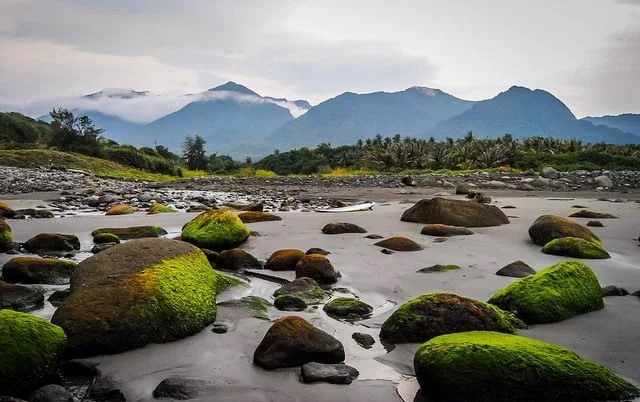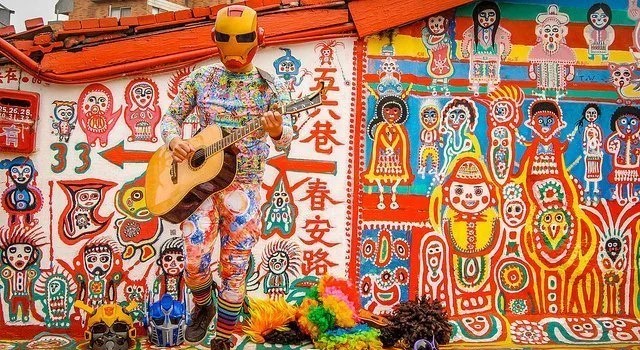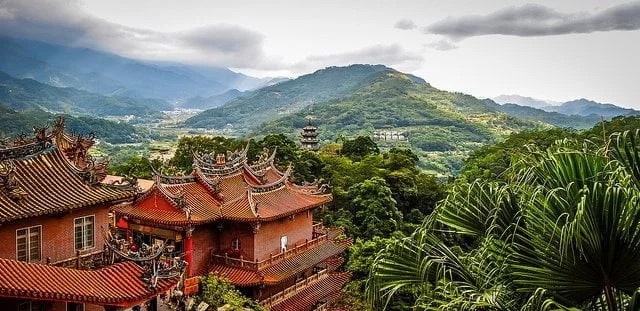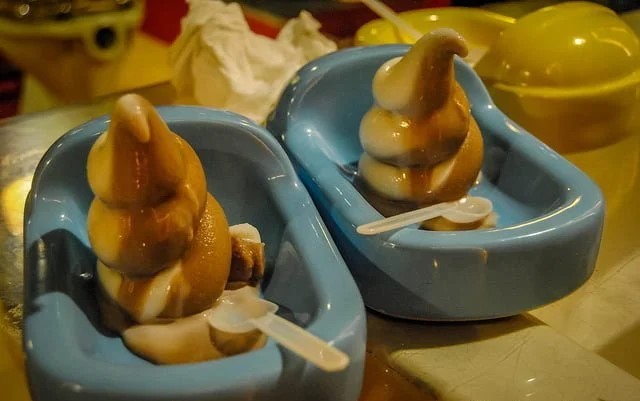Taiwan will always hold a special place in our hearts. It’s a place where the locals go out of their way to display enormous amounts of kindness to each and every foreigner they pass. It’s an island with chaotic night markets, sensational food, and garbage trucks that play Beethoven. Moreover, it’s a location with some of the most stunning and dramatic scenery we’ve ever encountered.
But not only does Taiwan boast a vibrant and inviting culture, it also has plenty of unique corners that promise to keep travelers inspired, engaged, and perhaps even confused. If a visit to Taiwan is in your future—and trust us, it should be—be sure to make time for these five offbeat destinations.
Long Dong: Dragon Cave
It’s only appropriate to start off with one of our favorite places in all of Taiwan. Located on the northeast coast, Long Dong (Dragon Cave) gets its name from the shape of the coastline, which resembles the body of a dragon. Spectacular sandstone crags rise 70 meters to the sky while crystal-clear waves crash upon the rugged, sun-baked rocks. Access to the base of the cliffs is only granted after following lengthy footpaths, which promise seclusion and isolation.
Long Dong is primarily known to the rock climbing community in Taiwan—and all of Asia—who flock to the cliffs to take on over 500 climbing routes. With options for sport climbs, trad, deep-water solo, and bouldering, both advanced climbers and beginners will be kept endlessly entertained. If viewing Long Dong from 70 meters high doesn’t exactly get you excited, there is also plenty of hiking and scuba diving to be had. Alternatively, bring your favorite book, find a comfy boulder, and enjoy the stunning surroundings.
Getting There
Reaching Long Dong is relatively straightforward but requires a bit of planning. From Taipei, you can take a bus from the Taipei Bus Station bound for Yilan or Luodong and get off at Long Dong Bay. The journey takes about 1.5 to 2 hours, offering scenic views along Taiwan’s rugged coastline.
Tip: If you’re carrying climbing gear, consider renting a car or hiring a taxi for convenience.
Activities and Attractions
- Rock Climbing: With over 500 routes, climbers can choose from various difficulty levels. The sandstone cliffs offer excellent grip and challenging overhangs.
- Hiking: Trails along the cliffs provide breathtaking views of the Pacific Ocean. Don’t miss the trail to Bitou Cape for panoramic vistas.
- Scuba Diving and Snorkeling: The clear waters are home to vibrant marine life, making it a paradise for underwater enthusiasts.
- Wildlife Watching: Keep an eye out for migratory birds and native wildlife that inhabit the area.
Best Time to Visit
The best time to visit Long Dong is from late spring to early autumn (April to October) when the weather is favorable for outdoor activities. However, summer can be hot and humid, so pack accordingly.
Accommodation and Facilities
There are limited accommodations in Long Dong itself, but nearby towns like Keelung and Ruifang offer guesthouses and hotels. For a more immersive experience, consider camping near the cliffs.

Dulan: Small Aboriginal Beach
Dulan is a small, aboriginal beach town 20 kilometers outside the large city of Taitung. Expats who have made it their home call it the Ubud, Bali of Taiwan, primarily for the burgeoning art and music scene originally cultivated by the local Ami Tribe. While the beach may not boast white sand, it does have some of the best surfing waves in all of Taiwan—hence why it is beginning to appear on the expat radar.
But because of its location on the southeast coast, few tourists or locals ever make the trek to Dulan, which promises ample surf space. Surfboards are easily rented from multiple bars and cafes down the town’s only main road. If you time your visit on a Saturday, be sure to visit the Old Sugar Factory, now a refurbished bar and café with live music. You’ll find the atmosphere in Dulan is notably different than the rest of Taiwan—slower and more relaxed.
Cultural Significance
The Ami Tribe, the largest indigenous group in Taiwan, has a rich cultural heritage deeply rooted in Dulan. Visitors can explore traditional crafts, music, and dances that reflect the tribe’s history and connection to nature.
Must-Visit: The Dulan Site, an archaeological location dating back over 3,000 years, offers insights into prehistoric Taiwan.
Activities and Attractions
- Surfing: Dulan Beach is a hotspot for surfers of all levels. The consistent waves and less crowded waters make it ideal for both beginners and seasoned surfers.
- Art and Music Scene: The town is dotted with art galleries and studios showcasing local artists. Live music events are common, especially on weekends.
- Old Sugar Factory (Dulan Sugar Factory): A hub for cultural events, art exhibitions, and performances. The venue transforms into a lively market on Saturdays with food stalls, handicrafts, and live bands.
- Cycling and Hiking: The surrounding areas offer scenic routes through rice paddies, coastal roads, and lush hills.
Local Cuisine
Dulan offers a variety of dining options, from traditional Ami dishes to fusion cuisine. Don’t miss trying:
- Millet Wine: A traditional alcoholic beverage made by the indigenous community.
- Seafood: Fresh catches from the ocean, prepared with local flavors.
- Aboriginal Delicacies: Such as wild greens, mountain boar, and rice cooked in bamboo tubes.
Accommodation
Options range from backpacker hostels and homestays to boutique guesthouses. Staying with a local family can provide an authentic experience and deeper understanding of the Ami culture.
Getting There
From Taitung, Dulan is accessible by bus or scooter. The scenic Highway 11 offers breathtaking coastal views and is popular among travelers.
Tip: Renting a scooter gives you the freedom to explore at your own pace.

Rainbow Village: Military Dependents Village
The Rainbow Village is a military dependents village, founded over 50 years ago. It has been transformed into the unique attraction it is today as a result of the talented Huang Yung-Fu, an 86-year-old who picked up his paintbrushes and personally covered the buildings with colorful animals and aboriginal-like people.
The majority of these drab, concrete houses have been demolished to make way for modern, high-rise complexes so common in cities across Taiwan. Luckily, thanks to the efforts of Huang Yung-Fu, the Rainbow Village will continue to be preserved. The village is quite small, so you won’t need much time to explore it fully; however, if you are in or around the nearby and popular city of Taichung, it is definitely worth the excursion.
The Story of Huang Yung-Fu
Known affectionately as “Grandpa Rainbow,” Huang Yung-Fu is a former soldier who took it upon himself to save his village from demolition. Starting with a simple brush and vibrant colors, he turned the drab concrete structures into a living canvas.
Impact: His artwork not only saved the village but also turned it into a symbol of perseverance and creativity.
Exploring the Village
- Artwork: The murals cover every inch of the village, including walls, doors, and even the ground. The images range from birds and animals to figures from Chinese folklore.
- Interactive Experience: Visitors are encouraged to take photos and immerse themselves in the colorful surroundings.
- Souvenir Shops: Support the village by purchasing postcards, prints, and other memorabilia featuring Grandpa Rainbow’s art.
Best Time to Visit
The village is open year-round, but visiting during weekdays can help you avoid the crowds. Early morning light enhances the vibrancy of the murals.
Getting There
Located in Taichung, the Rainbow Village is accessible by bus or taxi from the city center. Bus routes 27, 29, and 40 stop nearby.
Tip: Combine your visit with a trip to other Taichung attractions like the National Taichung Theater or the Fengjia Night Market.
Preservation Efforts
Thanks to public support and media attention, the Rainbow Village is now a protected cultural site. Donations and purchases help maintain the area and support Huang Yung-Fu’s mission.

Lion’s Head Mountain: Stunning Foothill
Shihtoushan, or Lion’s Head Mountain, is a stunning foothill located in the midst of dense jungle and bamboo forests. The main attraction at Lion’s Head Mountain is the Shihtoushan Historic Trail and its numerous temples built into the hills and tucked away in the caves. It is quite astonishing to contemplate how these temples were constructed, and why they were ever built in such a difficult place to access.
The most elaborate of all the temples is the Taoist Cyuanhua Hall, a three-story masterpiece where monks and nuns bustle about. Visitors can stay the night here, and the temple provides vegetarian meals in the cafeteria for around $2 USD. Allow at least three hours to wander about Lion’s Head Mountain, though it’s easy to spend longer; in addition to the paved Shihtoushan Historic Trail, there are ample walking and hiking paths that vary in difficulty and terrain.
Historical Significance
Lion’s Head Mountain has been a spiritual sanctuary since the Qing Dynasty. Monks and pilgrims have traversed these paths for centuries, seeking enlightenment and solitude.
Notable Temples:
- Cyuanhua Hall: A Taoist temple known for its intricate architecture and serene atmosphere. The three-story structure is carved into the cliffside, offering breathtaking views.
- Shengxing Station: An old railway station near the mountain, reflecting Japanese colonial architecture.
Activities and Attractions
- Hiking Trails: Multiple trails cater to different fitness levels. The main trail is well-paved, while others offer rugged terrain for seasoned hikers.
- Temple Stays: Experience monastic life by staying overnight in one of the temples. Participate in meditation sessions and enjoy vegetarian meals.
- Flora and Fauna: The area is rich in biodiversity. Keep an eye out for native bird species, butterflies, and unique plant life.
Best Time to Visit
Spring and autumn offer pleasant weather for hiking. Cherry blossoms bloom in spring, adding a splash of color to the lush greenery.
Getting There
Lion’s Head Mountain is located on the border of Hsinchu and Miaoli counties. From Taipei, take a train to Zhudong or Miaoli Station, then a bus or taxi to the mountain.
Tip: Wear comfortable hiking shoes and bring plenty of water and snacks.
Local Culture
The surrounding villages are home to Hakka communities. Explore traditional Hakka architecture and sample local delicacies like lei cha (ground tea) and Hakka rice cakes.

Taipei’s Theme Restaurants: Quirky Delights For Foodies!
Sorry guys—this one is a bit of a cheat because it’s a whole bunch of venues all wrapped up in one. However, no trip to Taiwan is complete without a visit to one of its theme restaurants. To understand why things like theme restaurants even exist, first you must know that it’s all about the cute, or ‘ke ai’, in Taiwan. The ‘cute factor’ extends into just about every realm of life, from fashion to names to relationships to food.
You mean food can be cute? Absolutely—although it’s not really the food as much as the general ambience that is essential. The most popular theme restaurant is the Modern Toilet, where seats are designed as toilets, tables as sinks, showerheads decorate the walls, and all food comes served in a miniature toilet bowl, including the signature chocolate swirl ice cream. However, if you prefer to keep your meals away from the washroom, try the theme restaurants devoted to Hello Kitty, Barbie, or ninjas.
The Culture of ‘Ke Ai’
In Taiwan, cuteness is more than an aesthetic—it’s a cultural phenomenon. This emphasis on playful and endearing themes permeates daily life, influencing everything from advertising to public transportation.
Notable Theme Restaurants
- Modern Toilet Restaurant:
- Concept: Dining in a bathroom-themed environment where seats are toilets, and food is served in mini toilet bowls.
- Menu Highlights: The signature chocolate swirl ice cream (resembling you-know-what) and hot pots served in toilet-shaped dishes.
- Experience: A lighthearted atmosphere that encourages laughter and photos.
- Hello Kitty Kitchen and Dining:
- Concept: A paradise for fans of the iconic cartoon character, featuring Hello Kitty-themed decor and dishes.
- Menu Highlights: Kitty-shaped waffles, cakes, and even hamburgers.
- Ambiance: Pink, cute, and filled with memorabilia.
- Ninja Restaurant:
- Concept: Enter a world of stealth and mystery with servers dressed as ninjas performing tricks.
- Menu Highlights: Japanese cuisine including sushi, tempura, and sake.
- Entertainment: Live performances and interactive experiences.
- Alice Is Coming:
- Concept: A whimsical journey into Wonderland inspired by Lewis Carroll’s classic tale.
- Menu Highlights: Tea party sets, themed pastries, and creative cocktails.
- Decor: Oversized playing cards, teacups, and murals depicting scenes from the book.
Why Visit These Restaurants
- Unique Experience: Beyond the food, it’s about immersing yourself in a different world.
- Great for Photos: Instagram-worthy moments at every turn.
- Fun with Friends and Family: Ideal for groups looking to add a memorable twist to their dining experience.
Tips for Visiting
- Reservations: Popular theme restaurants can get crowded; booking in advance is recommended.
- Budget: Prices may be higher due to the novelty factor.
- Cultural Etiquette: Embrace the experience with an open mind and respect for local customs.
Location and Accessibility
Most of these theme restaurants are located in Taipei’s bustling districts like Ximending, Zhongshan, and Daan. Easily accessible by metro or taxi.
